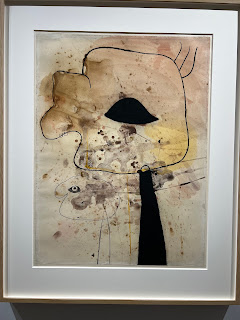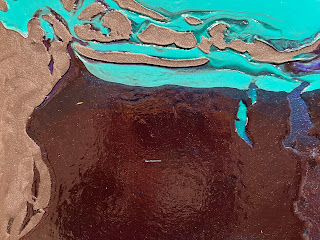Miro in the front room at Luxembourg + Co. Elegant and gorgeous, impossible to photograph. The occasion is a sampling of works from a twelve year period when he moves from detailed farmlands to abstraction, in the process developing variegated, even unstable grounds.
Stars of the show, presented on humanly proportioned easels: two paintings on chipboard, sent from Miro in Europe to Pierre Matisse in New York. These present the show's thesis and are from a group featured in the 1990s MoMA Miro retrospective catalog, though these do not appear. Compared to their companions these paintings are emptier, more experimental, less pictorial. They also come as close to Gorky as Miro ever will, or vice versa.
Dry, scumbled lead ground, limpid drawing.
A room dedicated to works on paper in which these two delighted.
There is a tendency in Miro to mark, then frame with drawing.
Returning to these chipboard works seeking this quality. Indeed the black frames the arbitrary paint.
The overlap of sheen as matte meets gloss, the pour on left, the fissured ground. DETAIL.
Show on until 26 September. Do not miss! You would have seen these works at the Independent Art Fair as well recently, where Luxembourg + Co. featured many on the easels. Most are in private hands.
Onward to Yares' epic Jules Olitski: 100 Paintings, 100 Years Centennial exhibition, celebrating the artist's process- and material-based work in the gallery's two locations, located conveniently down the hall from one another. https://www.yaresart.com/exhibitions/jules-olitski
The press release divides the work into series based on how they're made:Spray, Core, Squeegee, Mitt, and the late, great melds of landscape and abstraction that struck me into immobility at the Kemper Museum's Love and Disregard exhibition in Kansas City, 2010. The above is a Core work from 1961-2, Untitled #14, Magna acrylic on canvas,15-3/4 x 24-3/4 inches. The old Mary Boone Gallery space houses many of the Core paintings with such beguiling shapes and odd palettes, as if Olitski is doing his best to overlay design with color from another place, his native Russia?
But let's not tarry, and go straight to 2002's With Love and Disregard: Voices, acrylic on canvas, 68 x 92 inches (hmmm, interesting size). The magic of the Kemper show swept over me again. These late, super-saturated, stacked space/topographical landscapes were oddly installed closely together in the back room, and looked surprisingly great, immersing us into a new kind of terrain at once familiar through space craft photo but extremely textured, with fissured surfaces erupting from micaceous iron oxide and irredescent grounds.
DETAIL of gloss and earth textures together
Fissures, color, slabs of texture
Transparent, opaque, erupting together
Upper right hand corner, a peek of irredescent layers from the Mitt series
Further down, the stain of crimson over a fissure brings under to over.
This painting, AB, 1960, magna acrylic on canvas, 78 x 128 inches, like a hot and glaring sun, hung with the late paintings, across from Prince Patutsky Memoir: Pink, below, one cool and flat, the other volatile and permeable.
Prince Patutsky's memoir:Pink, 2004, acrylic on canvas, 60 x 84 inches.
Poured line, pumice ground, symbiosis of cerulean and purple.
Down the hall, in the old McKee Gallery, we find the hybrid work leading from the Core flatness to the textured opticality of the Mitt series to the late landscape-abstract hybrids in Halcyon Surge, 1997, acrylic on canvas, 72 x 60 inches. The variegated surfaces, the transparency coming in, so that spray paint does not float on texture, but within it, appears in this work and builds to crescendo with the Love and Disregard series of the aughts.
Forebars of Olitski's love of texture can be found in the offices, two works frm the fifties, the above one I'd own if I could.
Don't miss it.































No comments:
Post a Comment